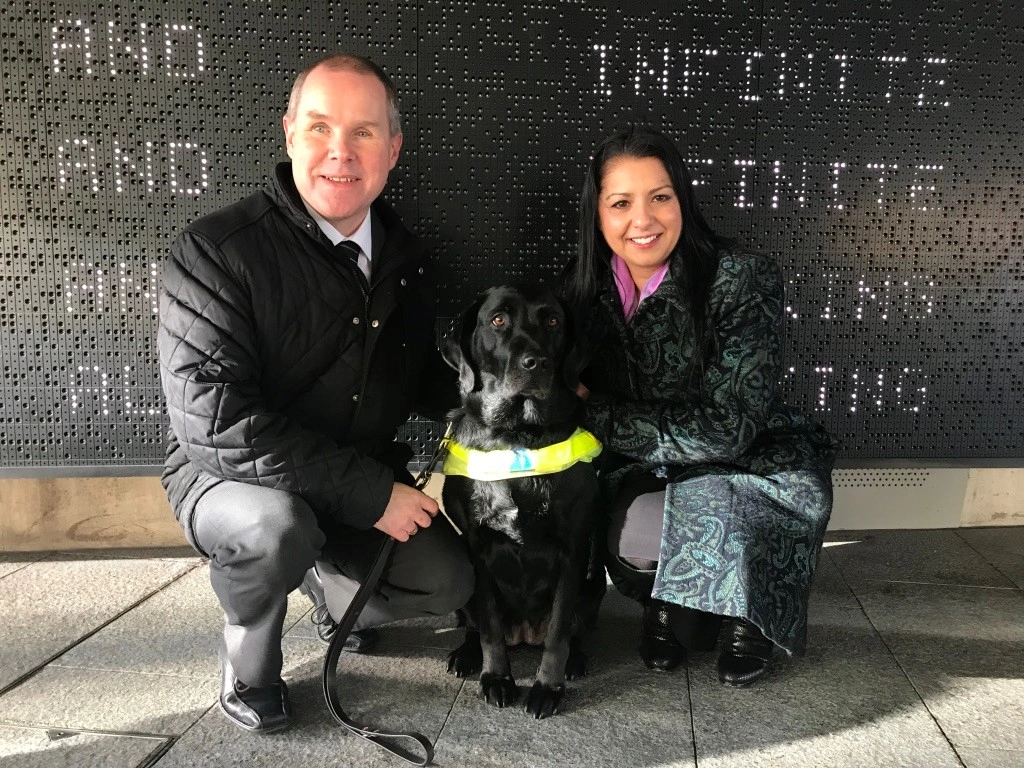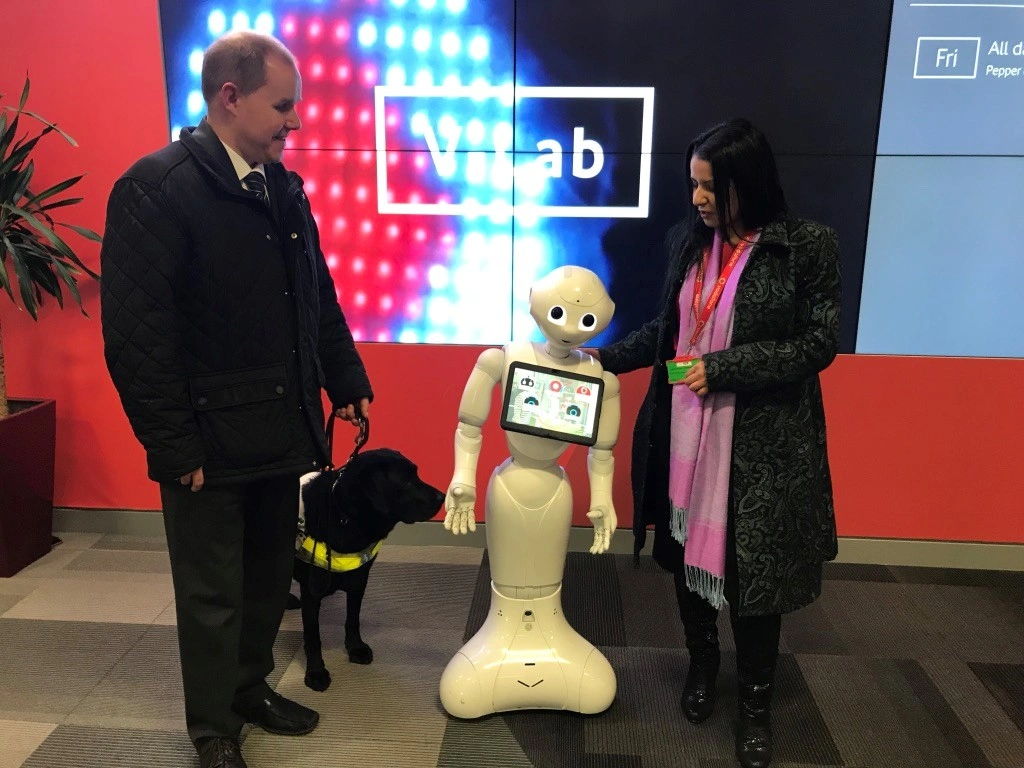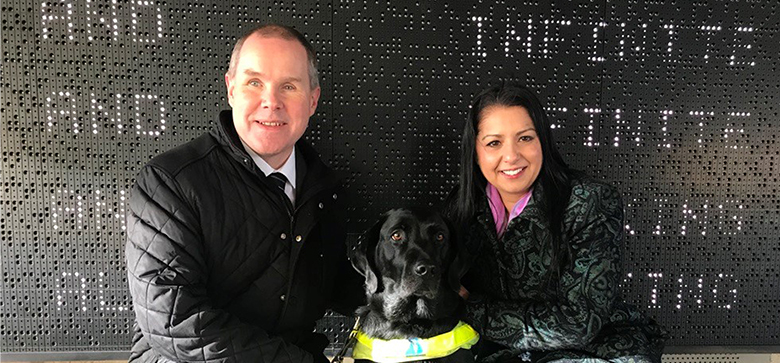When Rubi Kaur, a Senior Technical Architect at Vodafone Group, met diversity expert Barry Ginley, they were both studying for an Executive MBA at Henley Business School. The only difference was that Barry, who lost his sight at 25, was accessing online learning materials using a screen reader.
Sitting beside Barry and at times acting as his audio describer, Rubi witnessed first-hand how Barry navigated the world with his guide dog Skye and with the use of technology.

Rubi Kaur, senior tech architect at Vodafone Group, with diversity consultant Barry Ginley and his guide dog Skye.
After graduating<i style="font-size: 1.8rem;"> the pair stayed in touch and later, when Rubi was looking at ways to make Vodafone’s One Net for Business product more accessible to a wider and more diverse community, she contracted Barry as a consultant.
In our latest Gigalife Conversation, Rubi speaks to Barry about how they have been coming up with new and more inclusive ideas for One Net’s Operator Console, a software programme that acts like a digital receptionist, allowing business users to manage their call queues. Currently, the system relies on manual mouse control, which visually impaired users cannot operate.
Rubi gives us more insight into her job as a senior technology architect and what she’s learned from working with Barry.
I’m back at Vodafone for my second time…
I originally joined as a services architect in 2005 then returned five years ago to work as a senior technology architect in business unified communications, bringing fixed line and mobile together and applying technology to make new things happen. One of my projects is One Net for Business.
Diversity in tech is about building in simple inclusive solutions.
Working with Barry on One Net’s Operator Console product, I’ve learned how important it is for our products and services to be representative of our diverse society. Having an end user’s perspective is key to designing the best solution.
We need to provide audio announcements and voice prompts.
Barry explained these are vital ways for visually impaired users to be able to use the system and manage calls. We’re working on building these features in, so that users relying on screen readers will hear customisable tones to tell them they have an incoming call, as well as audio prompts so they can connect a caller to voicemail, or put them on hold, transfer them or perform other advanced call features. We’ll introduce keyboard hot keys and tab control to help them organise their calls speedily and more efficiently.
As a tech architect, we absolutely must be in tune with human empathy.
This means listening to our users’ needs and allowing compassion and humility to play an important role, alongside our technical skills. We must also consider ethical design, focusing on human values and the impact our technologies will have on empowering better societies.
Barry talks about ‘out-of-the-box’ working - and that’s the goal with our project.
If we design products with audio features built in, then customers won’t have to buy extra software packages to use technology the way they need to. No matter who you are, you can take your product out of its box, and it will work the way you want it to.
My tech role models are Ada Lovelace and Alan Turing
As pioneers in computer programming and Artificial Intelligence (AI), both have made enormous contributions to technology. On top of that, Turing is a huge role model for diversity. We can only wonder what else he might have achieved had his life not been cut short. Thankfully our world is now slowly moving forward to being a more inclusive, tolerant and accepting place.
Within my career, I’ve only ever worked with five other female technical architects.
We need to change this. We need to have a diverse workforce, because what it brings is innovation, people with different ideas, different challenges and viewpoints. If you’re a woman, or you feel you’re in a minority starting out in tech and you want to succeed, stick with it. If you’ve got drive, ambition and passion to get to where you want to be, you will get there.
I couldn’t live without my mobile apps.
We all need to stay digitally connected. The digital world means that our lives are lived both on and offline. My phone helps me stay up-to-date with breaking news, my travel plans, my social networks. But is everyone able to benefit from mobile apps? Are they designed to allow everyone to freely live their digital lives too?
Augmented reality is helping people become more connected...
…and devices are becoming more intuitive. That in itself is going to reduce many barriers. And it will help all manner of people to gain employment and progress within their careers.
AI and smart cities will mean we live in a world where everything is interconnected.
Our relationship with AI must ensure that no one is left behind and there are no unfair biases in the algorithms powering AI systems.
We really need to question deeply the ethics in AI.
And I think we need to strike a balance between technology, people’s rights, their privacy and data privacy as well.
We should be building tech for good...
…which is inclusive and protective of society and people’s data, so that everyone benefits. I think if we get that right, then we are on the journey to ensuring no one will be left behind.

Barry and his guide dog Skye meet robot Pepper, with Rubi Kaur.























